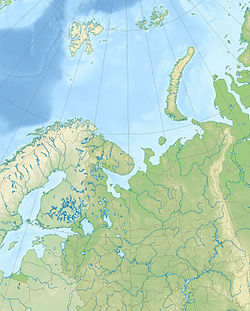Attack on Arkhangelsk
| date | June 7, 1701 to August 25, 1701 |
|---|---|
| place | Novodvinsk fortress , White Sea |
| output | Swedish failure |
| Parties to the conflict | |
|---|---|
| Commander | |
|
|
|
| Troop strength | |
| 7 ships, 1,000 crew members |
approx. 1000 garrison Novodvinsk |
| losses | |
|
2 ships |
21 dead |
1st phase: Swedish dominance (1700–1709)
Riga I • Jungfernhof • Varja • Pühhajoggi • Narva • Pechora • Düna • Rauge • Erastfer • Hummelshof • Embach • Tartu • Narva II • Wesenberg I • Wesenberg II
Arkhangelsk • Lake Ladoga • Nöteborg • Nyenschanz • Neva • Systerbäck • Petersburg • Vyborg I • Porvoo • Neva II • Koporje II • Kolkanpää
Vilnius • Salads • Jacobstadt • Walled Courtyard • Mitau • Grodno I • Olkieniki • Nyaswisch • Klezk • Ljachavichy
Klissow • Pułtusk • Thorn • Lemberg • Warsaw • Posen • Punitz • Tillendorf • Rakowitz • Praga • Fraustadt • Kalisch
Grodno II • Golovchin • Moljatitschi • Rajowka • Lesnaja • Desna • Baturyn • Koniecpol • Weprik • Opischnja • Krasnokutsk • Sokolki • Poltava I • Poltava II
2nd phase: Sweden on the defensive (1710–1721)
Riga II • Vyborg II • Pernau • Kexholm • Reval • Hogland • Pälkäne • Storkyro • Nyslott • Hanko
Helsingborg • Køge Bay • Gulf of Bothnia • Frederikshald I • Dynekilen Fjord • Gothenburg I • Strömstad • Trondheim • Frederikshald II • Marstrand • Ösel • Gothenburg II • Södra Stäket • Grönham • Sundsvall
Elbing • Wismar I • Lübow • Stralsund I • Greifswalder Bodden I • Stade • Rügen • Gadebusch • Altona • Tönning II • Stettin • Fehmarn • Wismar II • Stralsund II • Jasmund • Peenemünde • Greifswalder Bodden II • Stresow
The attack on Arkhangelsk from June to August 1701 was a failed Swedish naval operation in the Great Northern War with the aim of destroying Russia's only seaport of Arkhangelsk on the White Sea and preventing all Russian sea trade.
prehistory
At the end of 1700, the army of Peters near Narva from the Swedish relief army of Charles XII. smashed . Despite this severe defeat, the Russian armed forces quickly recovered . When the main Swedish army turned to Poland , a direct threat to central Russia was initially averted. However, Peters advisers continued to calculate a Swedish threat at sea.
Arkhangelsk on the White Sea was Russia's only maritime access to the world's oceans for the import of European products and therefore of great strategic importance for Russia. Peter gave the order to strengthen the garrison in Arkhangelsk. In the spring of 1701, the Novodvinsk fortress was built on the island of Linski Priluk about 20 kilometers northwest of Arkhangelsk, with a garrison strength of 1,000 men. In the Dwinamündung six were Brander provided to set attacking Swedish ships on fire. At the same time, the incoming foreign ships were detained in the port. It should be prevented that the attacking Swedish ships could be informed about the defensive measures in the Dvina estuary.
course
On June 7, 1701, a Swedish flotilla of seven ships, armed with a total of 127 cannons, left Gothenburg on the White Sea course. The ships were:
- Warberg (42 cannons)
- Elfsborg (42 cannons)
- Marstrand (26 cannons)
- Falk (6 cannons)
- Töfva-lite (4 cannons)
- Mjöhund (6 cannons)
- ??
The flotilla was led by Commodore Carl Henrik von Löwe . It had the order to destroy Russia's only seaport and to prevent any import of goods and weapons from Europe. For reasons of secrecy, the Swedes were camouflaged as whalers under the Dutch and English flags, but were exposed by English and Dutch merchants. These warned the Russian side early on. The flotilla reached the Northern Dvina in late June. Lewe dispatched three of its seven ships to scout the area using local helmsmen who were supposed to guide the Swedish ships safely along the coast. To do this, the Swedes captured two Russian fishermen. These were Ivan Sedunov and Dmitri Popov. They risked their lives by maneuvering two of the Swedish ships in shallows.
The reconnaissance team first attacked a Russian outpost at the mouth of the Dvina, killing 16 men. They continued their advance into the mouth of the small Dwinka where the new fortress was built. The staff officer in command there, Zhivorovsky, went to meet them with 700 soldiers on small boats. Five Russian soldiers were killed by the Swedish ship fire. But before they got within range of the fortress, a frigate and a yacht ran aground.
Due to the White Nights in these latitudes, the ships were sighted by the Russian garrison and henceforth shot at from the fortress. When the captain of one of the Swedish ships was killed by one of the projectiles, the crews left the two incapable of maneuvering ships and climbed aboard the remaining Swedish ship.
Two other Swedes were wounded. The Mjöhund and the Falk fell into Russian hands. The rest of the Swedish fleet stayed in the waters of the White Sea and hijacked fishing boats or burned Russian villages. On July 21st they sailed back to Sweden. They arrived in Gothenburg on August 25th.
consequences
The victory at the mouth of the Dvina also secured Arkhangelsk from further Swedish attacks. Its port remained freely accessible to European ships until the end of the war. The Swedish ships were brought to Arkhangelsk and were put into Russian service.
literature
- RC Anderson: Naval wars in the Baltic . 1969, p. 137.
- Peter Hoffmann: Peter the Great as a military reformer and general . 2010.
Individual evidence
- ↑ Peter Hoffmann: Peter the Great as a military reformer and general, p. 64

